Finding a ’70 Chevelle that is pretending to be something that it isn’t is a simple task. Go on-line to any one of several collector car for sale websites and you can find several in a short period of time. It’s refreshing to find a really interesting, modified car that is what it is and makes no bones about it. Here is just such an example, a 1970 Chevrolet Chevelle Malibu with a 454 CI engine. This Malibu is located in Levittown, Pennsylvania and is available here on eBay for a current bid of $15,101, fifteen bids tendered so far.
The 1970 Super Sport (SS) 454 “LS6” Chevelle is the substance of muscle car legend with its over-the-top 450 gross HP rating. That probably doesn’t sound so impressive today but a half a century ago, it was heady stuff. There were approximately 4,400 such equipped Chevelles manufactured though as a friend of mine likes to say, “Of the 4,400 manufactured, there are only about 7,000 still in existence today.” Yes, they have been heavily cloned. But an SS equipped Chevelle, while built on a Malibu trim level, does not identify itself as a Malibu, it’s identified as a SS. Our subject car is true to its origins, it is a Malibu, advertised as such, it just happens to be fitted with an engine that was not available in a Malibu.
This Chevelle is obviously a Malibu, it still retains its fender badging, stainless steel trim along the top of the fenders/doors and its rocker panel molding. The listed VIN indicates that this Baltimore built Malibu originally harbored a six-cylinder engine so this Chevy has undergone quite the transformation! The Cortez Solver finish, very popular on SS and non-SS models alike, looks strong with no fade. The body, as well as the underside, appears to be rot free, rust being a bedeviling problem with this vintage “A” body. The only notable digression away from Malibu trim is the inclusion of the”SS”, non-cowl induction, domed hood and the black painted grille.
As sharp as the exterior is, the interior is not quite up to snuff, the offending item being the front seat. There must be an ongoing sale on red duct tape that I don’t know about because this is the second car that I have encountered this week that is slathered with the stuff. Beyond that, the headliner is missing but the rest of the interior checks out pretty well. The red carpet is faded, nothing unusual about that and the front seat can obviously be fixed but its atrocious condition really detracts from an otherwise, sharp, overall presentation. The headliner is another matter, a correct one is a tedious, expensive item to replace in this vintage Chevy. Obviously, it’s not necessary but if a potential new owner wants a more finished off environment, it will be something to consider. As expected, the instrument panel houses a typical Malibu horizontal speedometer. While the bench seat is standard for a Malibu, it was also standard for an SS model in ’70 (and the bench seat with manual four-speed shifter is a neat combination!). Bucket seats and a center console were standard on a ’64 & ’65 Malibu SS, but when that model morphed into the SS 396 in ’66, the buckets/console combo became an option and remained that way through ’72.
Under the hood is a 454 CI V8 of unknown origins, not that it matters. The seller is pretty mum regarding the engine other than to give some details regarding the carburetor and intake manifold. He does claim, “This is a reliable muscle car that drives well, you can drive and enjoy with confidence.” Sounds like this is a good, driver quality car. Behind the big-block motor is a Muncie, M21, close-ratio, four-speed manual transmission activated via the previously referenced Hurst shifter. Bringing up the rear is a twelve-bolt differential containing a 4.10 ratio, limited-slip gear set. Bringing all of this oomph to a standstill is a four-wheel disc brake arrangement – a very nice upgrade as the Malibu was still futzing around with drum brakes, as standard, on all four corners in ’70.
Of particular interest is the inclusion of a rear adjustable suspension on this Chevelle. I find this type of arrangement occurring much more often as of late with restored muscle cars, not to mention being a mainstay on resto-mods too. The seller adds that there are new front end suspension components that have been installed too.
It’s hard not to like this Malibu – it’s genuine, it’s not trying to pose as something that it’s not. You could own and drive this car in any situation and not worry about knocking down the points on your “show-ready”, restored SS. And I have to believe this one is probably a thrill a minute on the road. The auction has six days to go and we’re still in reasonable territory for all of the goodness baked into this Malibu. What do you think, any takers out there?
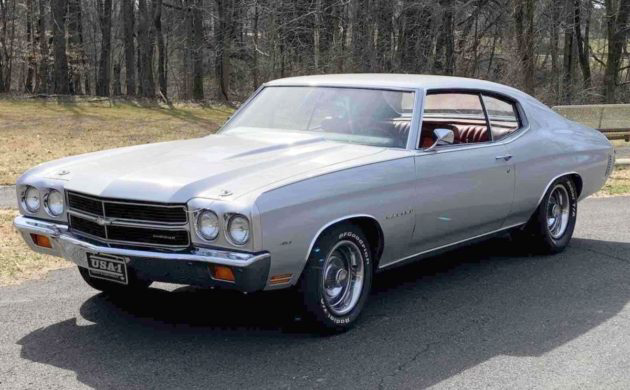
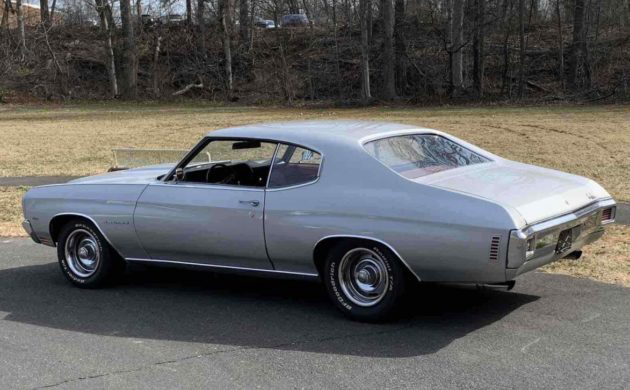
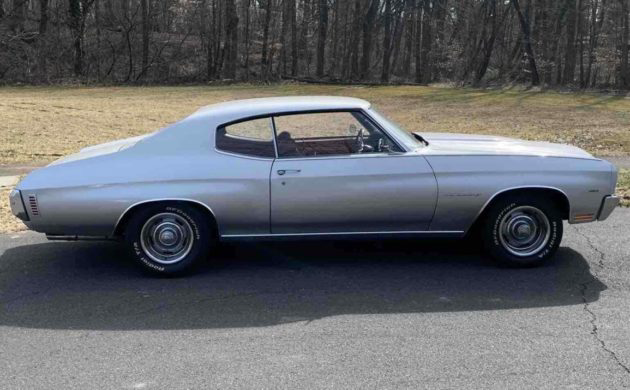
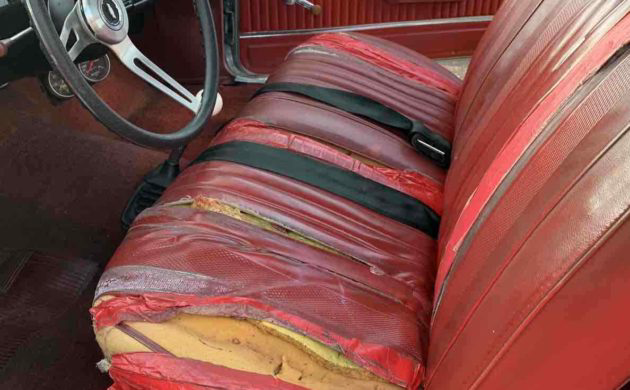
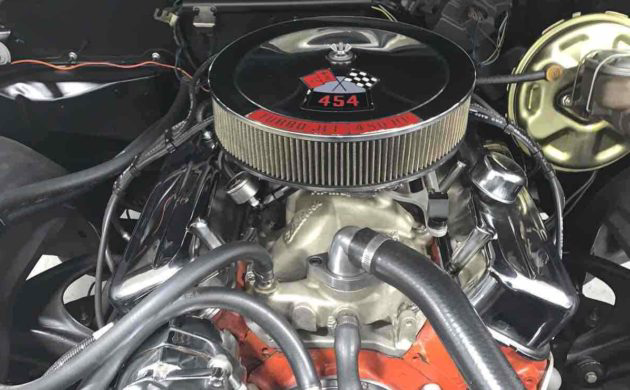
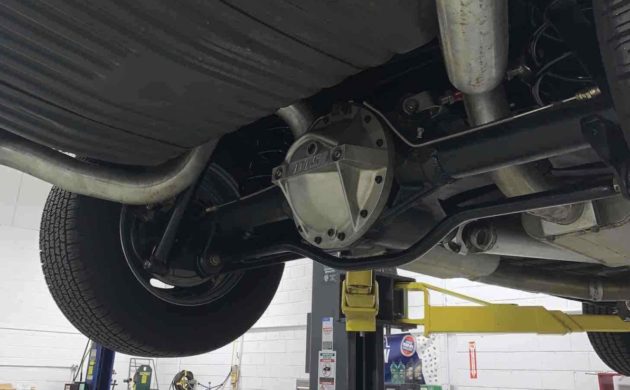



Nice car. Nice sleeper.
Could you get a non ss chevelle like this from the factory with the most powerful 454 in ’70 by special order or “if you knew someone”?
Would be a heck of a sleeper with no badges,flat hood, whitewalls & wheelcovers.
Could be a flexalite full flex fan i partially see.
How could chevy STILL not build a car like this today, while Dodge has had good sales with essentially the same challeger since 2008!
Dumb!
Less so, tho, with Ford & a Torino, i guess.
No, but you could get a 396, which had 400 emblems in the fenders. It was the LS3, which had a lower horsepower rating than the base SS’s L35.
People will claim you could get almost any engine, if you knew someone, but they need to provide documentation to back up their claims, which, of course, has never happened.
Steve R
Just to clarify, the 396 engine in 1970 was actually a 402 cubic inch engine, the result of a factory .030 overbore. Chevrolet continued to call a the car the SS 396, why mess with success?
The 400 was actually a small-block engine, with siamesed cylinder bores that allowed a large enough bore to achieve the 400 cubic inches.
To this build I say,” Bully!”
There was a 400 big block also. John is absolutely correct. In fact, in 72 ( not sure about 71) they stopped calling it a 396 and called it a 400.
This car here is really cool.. they did a great job , all the way down to the 12 bolt rear. Nice that they did’nt clone an ss.. but they could of ! This is done right. Its funny that you do see “SS” cars and when you look underneath you see a 10 bolt rearend..they are’nt even cloned correctly. To build on JoeNY comment, I don’t think you could of ordered a 454 in an SS , and a 396 Malibu , non SS , I think would have a 10 bolt rear. This is another car I wish that I could buy!
Id do the interior and enjoy..it would be in garage for winter (obviously) and enjoyed in the summer
At 25 bucks in gas every time I go anywhere it makes it an event, not a driver.
My 73 Grand Prix is an event also, it burns 20.00 per hr with the a/c on, worse on the highway, maybe I like hearing the Quadra jet suck my money down it’s throat, it’s not really a problem, when I have an extra 50 I take it out
Bill Irby you are only half right. Yes the 400 was a small block but the 402 was a big block
I’ve seen the 400 decal on the SS 396 stock air cleaner. Turbo jet 400 sticker, 402 cubic inches, still using the SS396 badges. Reminds me of the 351 Ford dilemma.
Sharp looking car here in Cortez silver but the interior blows in red. I like how all the mods are “non advertised”,,, one things for certain, it’ll go from one gas station to the next quicker than snot with those deep gears! Looks like a fun runner.
Nice car though it does need to be finished inside. I’d want to know which 454 is under the hood. A 1974 LS4 had 235 – 275hp and the later LS5 454 had only 235hp. The ’70 and ’71 454 LS5 had up to 360hp; 270hp in’72. The early 454’s had 11.25:1 compression so you’d need to feed it a high octane fuel. It’s always impressive to see a 454 in a Malibu/Chevelle but I’d rather have the L78 396, or a built small block. Still, I like this car; it’s a nice one.
The nearest thing we had to these were the 1970 Holden Monaro with a 350 Chev, although the 1971 HQ Monaro takes it’s styling cues from the Chevelle so much nostalgia
This seems like a very nice car except for the terrible front seats. The 396-454 four speed Chevelles were fun to drive and most of the people who kept them probably had to overlook the 9-11 gas mileage. We usually had another car that we drove to work, etc.
There does seem be some confusion about the many 1970 Chevelle engine options. The 400 small block was not an option for 1970 in a Chevelle and only offered in the full size Chevrolet and Monte Carlo as a LF6. I think some people refer to the 400 small block LF6 in the Monte Carlos as 400-2 because it had a 2 barrel carburetor. Some 400 small blocks did have four barrels in different models and years.
At one time in 1970 I was interested in ordering a 1970 Chevelle Malibu with what I thought was a 400 cubic inch small block with a Turbo 350 transmission rated at 330 HP. I was trying to get under the radar because insurance rates were going sky high because of muscle cars. I didn’t realize until later that this 400 small block engine was a 402 big block with 330 HP(LS3). I then found out that what I incorrectly thought was a 400 small block had the same high penalties as all the 396s and 454s. After finding out I was going to pay premium insurance rates anyway, I decided on upping my order to the L34 (402) 350 HP and 4 speed (M21). After adding AC which added 100 pounds, I upped the order again to a 454(LS5) and the factory made me change the order from a M21 to the M22 transmission. The 454 option was quite a bargain at only $59 more than the “SS396” option. The required heavy duty M22 transmission for a 454 was about $34 more than the M21 and a very good deal, too.
You were a smart guy, to order your car the way you did, bet you’ll never forget that car, I was 7 yrs too young in 1970, but I remember the summer well, because of all the muscle cars, great days
John, I will never forget the car, but it wasn’t a very good decision to sell it. It was the only new car I owned which didn’t depreciate. After owning it, the other cars I see today don’t impress me that much even if they are much more expensive and faster, etc.
The car came to Dennis Collins’s attention who realized what it was and advertised it. The car was featured on Barnfinds in Jul 11, 2017. Dennis Collins also has a very good Utube video in Jul 5, 2017 featuring it, too.
https://barnfinds.com/?s=454+4-Speed+Survivor
https://www.youtube.com/watch?v=nsdZagxPQso
1970 Chevelle LS6 454 could be bought with 450 advertised horsepower. I know ,I had one. Bought in Fork Kent, Maine in Febuary of 1970. 500 lbs. of tork. In today’s standards, a small amount. But at 6 to 9 miles per gallon, leaded gasoline only, it’s not driveable with the fuel available today. Phantom blue with white stripes, M-22 rock crusher muncie tranny and 12 bold posi rear. If you want to fact check, send me a note and I’ll respond.
Got your message and it was sure an unforgetable car. In 1970, the 396 was bored 30 over to 402 but still called a 396. A 454 with 450 hp was offered for the same price (4400 hundred) and I took it. What luck .A lot of money at the time. Th problem was the 3.31 rear end. Clutches galore. Replaced them with 4.88 and went 7.69 sec in the eighth mile at 96 mph, 11.6 at 114 mph in the quarter mile and saved my clutch. Really enjoyed the car when I owed it. It’s now in Texas in a Chevy dealership as an attraction.
David, your comment about your Chevelle with the LS6 made me think about a memory I had in 1970 at Richmond Dragway. There was a new 1970 SS454 Chevelle that was red with white stripes who ran a number of times that day. On one of his first runs it looked like he picked up the left front wheel a few inches off the ground and carried it some distance until he shifted to second. After watching him again he did pickup up the wheel each time he ran. It was fun watching him run and thrash that M-22 which took it. The low gear of the M-22, which had a 2.20 ratio, would go pretty far before he had to shift. I don’t remember the times that day, but I think his powerful sounding Chevelle might have did 114 or 116 MPH on some of his runs. It was impressive.
Jack, the secret to this kind of performance was to tie those 11″ x33″ high slicks to the track and that sticky compound to make it go. That brute hp was also a big help. It’s also nice to see people who actually appreciate these mean machines.
THANKS
Thanks
Dave
Dave, the F70-14s that came on the LS6s from the factory definitely didn’t help hook up any of those Chevelles. It seems that in 1970 most people were still using 4 speeds at the track. I can remember that in 1965 that there were about 15-18 GTOs running in the same class against about the same number of 1965 Chevelles which had 327s. At that time it didn’t seem fair to have the big blocks versus the small blocks, but it seemed to be a tossup as to which cars were best All of the GTO and Chevelles had 4 speeds and those people were very hard on them. Some of the sounds of those transmissions getting thrashed sometimes made you cringe and glad you didn’t own them.
Hey Jack, you’re right on all counts with factory rubber and do include M-22 four speed rock crusher. By the way , the 327 came with 325 hp in the vets was quite the sleeper. That 327 could beat most big block of other makes beside Chevy big block.The 396- 375 hp or the 427-425 hp. were quit the beasts. On the track, I never hurt my 4 peed but I did take a few rear ends out. HA. Speed shifting and all. Floor it at take off, release it at the end of the track. Quick clutch to disengage to,quick shift and move on. Fun days.
Dave, you apparently witnessed that era I mentioned where the 64 -65 GTOs were taking on small block 64-65 Chevelles. The Chevelles must have been mostly 1965 327s with 350 HP and 4 speeds. The automatics in the 64-65 Chevelles were the two speed powerglides which nobody was racing at that time. The Z16 in 1965 was a special package 396 with 375 HP with hydraulic lifters, special hood, paint etc. I think they only made 201 Chevelles with the Z16 package and I never saw one at the drag strip. The 327 Chevelles took the battle to the GT0s very well. I wouldn’t be surprised if some of those 64-65 Chevelles had the 300 HP engine and a 4.11-4.56 gear and a few modifications you could get away with at that strip. In 1966 I also don’t think they made many 396 375 HP Chevelles until late in the year so the 325HP and 360HP had to battle with the GTOs. The very limited production 396 375 HPs were awesome with the big valves of the 427 head, etc and it was always said they really had at least 425 HP or more.
Dave you sound like a friend of mine who used to do an unbelievable job of shifting. Some people just do it a lot better than others. Horsepower losses due to an automatic transmission seem to always cause the 4 speed muscle cars to have the advantage depending on the driver. Now days things have changed so much that those new cars aren’t worrying about losing horsepower because of an automatic. I still think the automatics feel sluggish compared to the positive feel you got from a big block muscle car with a four speed.
I knew I wasn’t a talented shifter like some others so I was conservative and tried to preserve my 1970 454 Chevelle. When I sold it, the buyer said one of the reasons he flew down and bought it from the pictures was that it still had the original Muncie shifter so he knew I wasn’t racing it, ha.
Like reading about the era these factory performance cars came from. Born in ’66 so I missed it when they were new cars. Like the stories about the SS327 versus the GTO, not sure but I’m thinking the Chevy guys had a lighter car and the 327 really was a solid performer,, especially tuned. Where were the 442’s, the Fords, mopars?
4 speed shifting really is an art form to be that good, always the chance of missing a gear though, which ends it. So I figure driving skill was a huge part of it ! Great stories up there.
Shifting is called “speed shifting” more crudely called “banging gears”. Was allot of fun. Only with a standard shift. Young guys-fun cars.
In NY, we used the term Power Shifting
In the Chicago area, “power shifting” was never letting up on the gas between shifts. Needless to say, very, very few people were good at it. “Speed shifting”, to us, was letting up on the gas between shifts somewhat, which was the majority of folks.
Yeah, power shifting was the what I called it. Foot down on the gas side stepping the clutch and ripping the gear shifter. The only car I ever did that in was my ’86 5.0 mustang ….not even the same thing though. Those old 4 speeds had a stiff clutch! Then someone asked either Ronnie Sox or Don Nicholson how he could shift so fast, his reply “I never used the clutch” absolutely boggles the mind. Talk about talent….and free parts!
In 1970, the 454/450 hp had solid lifters with space between the valve stem and the rocker arms so the the valves would close for the compression stroke the lash was 12 thousands intake and 8 thousands exhaust. Allot of work on race day. But fun. No hydraulic lifters.
These cars came from the factory with muncie shifters that were less then addequit for use on a race track. I replaced it with a Hurst verticle gate shifter and that was the trick for power shifting (as you call it). I also used the term power shifting from time to time. That is , down on the peddle all the way down the track and my tranny held up. But also didn’t miss many shifts. Just banged them hard.
Dave, the way you describe your shifting I guess it would be called power shifting versus the speed shifting others were doing. Many people said it was a skill that would require going through a few transmissions before you got the knack of it. The M-22 “rock crusher” in your LS6 1970 Chevelle apparently lived up to its name.
A lot of those people racing the GTOs and 327 Chevelles in 1965 were using the clutch and letting up on the throttle between shifts. They would look like they paused a little bit and then you would hear them smash the shifter very hard. It also seemed that there were a few GTOs that would sometimes miss a gear. The early GTOs which had the 389-400 engines had the M20 and M21 four speeds which were not as strong as the M-22. I think they didn’t put the M-22 in a GTO until 1971 and that might have been because of the 455 engines.
All the GTOs and SS Chevelles in 1964-65 were nice cars and those of us watching couldn’t afford any of them. We couldn’t believe how hard the people seemed to be on them. The 1965 GTOs and the 327 Chevelles (L79 – 350HP and 325HP) all had hydraulic lifters, but the L79 had a special high performance cam. The 327 Chevelles with the L79 engines were really not at a disadvantage to the muscle car GTOs during that era. Normal hydraulic lifters in my experience seem to pump up at about 6100-6200 and you would lose power. I remember seeing more than a few overrev the GTOs and Chevelles causing them to sputter and sometimes backfire. A lot of those cars didn’t seem to have tachs or any kind of rev limiter back then. It was easy to take them past 6200 RPM.
Oh, missed a shift or two myself. Not fun. Over revved and screwed up my run.And with today’s automatics and the way they shift,it’s impressive. But it takes the fun and the talented shifter out of the game. Then it’s all about timing on the start line. Back in the day, we used to put a “shift kit” in the automatics for faster shifting and less slippage in the tranny.
When the gas could no long support the 11.5 to 1 compression ratio from the factory, I replaced the closed cambered heads with open chambered heads to lower the compression ratio and the horse power and I realized that torque is more important then horse power.
In the early 70’s lead was removed from gasoline mandated by the EPA for a supposed cleaner burn . Some other cleaner burn control additive was added. It kind of satisfide the EPA. With the high compression in those beasts, talk about spark knock or pinging. Sounded like a hammer inside the engine. We used to put some “led additive” in the tank to control the burn for maximum horse power. Then it became a science. Oh, the fun days.
Dave, you mentioned the transmission shift kits that were used at the strip. My best friend and I got into 4 wheel drive mud racing in the early 1990’s. We were racing Chevrolet trucks and due to the transfer case issues that would be involved in going to a Turbo 400 we did like a lot of people and stayed with the Turbo 350. We used all the available after market products to beef up the transmission. I remember there was a medal ring in the Turbo 350 that might have been the weak point and we replaced it with a HD unit. We had the shift kit to increase the shift range to a lot higher range than the standard 4600-4800 range. I think the shifts were increased to 5800 rpm. I remember those 4 rubber balls which were suppose to slow down the flow and give you smooth shifts on the street and you had to remove some of them to speed up the shifts.
I have seen some people who took shots at the Turbo 350 versus the Turbo 400. Some people also say the Turbo 350 had faster shifts and there was a lot more you could do with them than a Turbo 400. We never had any trouble with the Turbo 350 transmission, but the 12 bolt rear couldn’t take the torque since we were racing in the low range of the transfer case. Going to the HD 14 bolt Chevrolet truck rear solved that. Our Turbo 350 transmission had an unbelievable quick shift after it was modified which you really could feel at part throttle operation. It felt like you were slamming the gears on each shift even a low speeds and it would jerk you back some.
Dave you remember the Sunoco 260 ads where they had real high test that didn’t knock and ping if you had a high compression ratio. You could also increase your timing advance to get more horsepower and didn’t have to worry about damaging your engine. They started cutting the lead from gas in steps in 1975 and also lowered the octane rating on high test gas. I think that Sonoco 260 was said to be 104 octane and now I think the rating of the ethanol high test gas is about 93.
There was a excellent Gulf No Knox ad on Utube with a 67-68 Camaro Z28 that said it had 425 HP. The only sound was the car screaming through the gears and now they have taken it down. This Gulf ad was shown on the Walt Disney Show in 1969. It definably would get your attention and many of us remember it.
Hey Jack, you certainly bring me back a few. Yes I remember so well Sunoco 260 and that was all I could use for no ping gas. I also used that car for my every day travel. Once on the track, we’ed disconnect the vacume advance tube and time the engine at 18 degrees btc so that we could get a maximum 38 degrees btc at 2500 rpm. Some tricks I learn alone the way. We also disconnect the headers for maximum noise.HA and breathing ability for the engine.
The shift kit was a gasket with plastic balls and a replacement plate for the valve body to redirect the oil flow. And as you say, these kits worked better in the turbo 350 then in the 400. The kits were advertised that way. They would shift so hard under power that if you has enough hp you could break rubber at to 2nd.I never raced an automatic but I worked with guys that did and I did the test drives,HA
Did I tell you that this chevelle was all over the track with stock posi-track unit I replaced it with a Moroso super brute posi pig. That did the trick. Straight line all the way down the track.
Dave, the factory positractions in the12 Bolt rear might not have been too strong. We broke a factory positraction in a Blazer which had a 355 in it. Of course we were in the low side of the transfer case and they always warn you against doing that. We replaced the Blazer with a truck body and I think it was a Moroso positraction and we didn’t have any more problems until we changed engines and went to a 383 with 13 to 1 compression ratio using racing gas. That engine broke the 12 bolt rear gears on the first run. That run was recorded and you can see my friend Buck hesitate at first when he broke the 12 bolt rear and then he hammered it coming out of the extremely thick mud. We actually won first place that day as most people couldn’t get through the very thick mud that day. I also have a second tape taken another day after we replaced the rear with a 14 bolt and Detroit Locker when the mud was not as thick, but we only came in third that day.
https://www.youtube.com/watch?v=inxFxvpBG44
https://www.youtube.com/watch?v=b-BFQ70aCtk
Dave, it is interesting that your Chevelle’s factory positraction couldn’t take the horse power and torque of your LS6. You don’t know if yours would pick up the left front in low gear?
Its funny that in the Jack Reader movies where Tom Cruise drove a 1970 SS454 Chevelle that they had to take the C clips out so that the rear would slide in the action scenes. That Chevelle must have been hooking up too well before they did that and they wanted it fishtailing.
Positraction was a must for anyone serious in the old days. For some reason Ford seem to let a lot of its cars come through without it. From what I have read, the famous Steve McQueen Bullitt Mustang in the movie really didn’t have a postitraction rear. In the scene where he has to back up and go up the hill the right rear is really spinning and if you notice, he is not rapidly moving up the hill like he should be. I also read that one of the Mustangs used in that scene had a line added for the left rear wheel to provide smoke so that it would look like both wheel were spinning. A really great movie and I wouldn’t say many things could have been improved. I did notice that later after Steve got up the hill and they were going down the hill in those jump scenes that at the very end before the scene pulled away that the 440 Charger which had been staying at an even distance away really started pulling away from him.
That second link I sent doesn’t work so I am trying this one. In this link the mud was not extremely high that day like in the first one which almost stopped us and my friend Buck was able to move through it pretty well.
https://www.youtube.com/watch?v=9E4Pf9BIy9k
Hey Jack, you probably know this about the Bullitt cars, ,,after the cars had been set up they took both cars somewhere to give em a run, testing so to speak…..the Charger could run circles around the green mustang. Outperformed it in every way. Bill Hickman said in an interview that he had to slow down a lot to let the Mustang keep up during filming.I remember that part of the movie you’re referring to, the Charger starts pulling away noticeably easy. Funny, despite the mods to the 390 the Chargers 440 was basically stock.
I read years ago that some race car/ engine builders felt the 454 made too much unnecessary torque down low and preferred the 427, less breakage I’m thinking? You guys would know more about that then me as the biggest Chevy I had in a Chevelle was a 396 bored .40 over, I always said it was a 404, haha, turbo 400 with a full manual valve body, loose converter and b&m rachet shifter that proved unreliable.
I can still smell the Sunoco 260
How does taking out the c-clips allow the car to slide? The axles would have to be retained with an adaptor at the backing plates if you remove the c-clips, I don’t understand how that would help the car slide. No criticism, I just don’t get how that would make a difference.
Look guys, I never mentioned any thing about removing any c-clip. In Chevy 10 and 12 bolt rear ends the c-clip holds the axles in the rear end. If you take those out, the axles wouldn’t stay in.
Also, remember that Hollywood can do anything they want in a movie and most people who don’t know will believe any thing. I’m a mechanic and I’ve worked on a lot of cars. I said I replaced the stock posi unit pig with moroso unit. If this car would not have been my day car also, I would have replaced the posi unit with a spool.
John that is good question and maybe Dave or some of the others can answer this. I remember that they said C clip eliminators were used on the car and the reasoning seem to be it was suppose to make his Chevelle drift around the corners. I found these two comments in the write up about the movie and have the link where you can find the video and write up of the movie.
“The final touches included c-clip eliminators with a 12-bolt rear end that were fitted to the stunt cars to allow for the intense cornering performed in the film’s action sequences.”
“The scene is easily one of the best chase sequences in recent years for all of its spectacular drifting and edge-of-your-seat near misses.”
https://www.youtube.com/watch?v=lfeYgfKa2cY
Hey, it’s all good! Hollywood can, and does, say a lot of things. The problem is people tend to believe them!
Troy, I am glad you noticed that the 440 Charger was pulling away hard at the end of that scene. I would have expected the 440 Charger to run good on the top end once it got going. The Charger was suppose to be stock and probably had a 3.23 gear. The 440s had a good reputation for running strong on the top end. They were widely used in police cars doing that period.
I am not sure what those engine builders meant by the 454s having too much torque on the low end. Both the 1970 454s had 500 ft pounds of torque at 3600(LS6) and 3200(LS5) RPM. The 454s had more torque than the 427s which had a shorter stroke and was said to be faster and higher revving. You could probably get into a spirited debate over the 427s versus the 454s.
The L88 427 with the aluminum heads and 12.5 compression ratios were bad machines in the 1967 Corvettes, but very rare. In the 1969 Corvettes, which were the last L88s, they changed the heads and reduced the compression to 12.0. These heads were suppose to flow better. The only problem with the L88 engines is that they only made about 200. The L88 aluminum block ZL1s is also rare and only 69 were put in Camaros. The differences between the LS6s and L88s is that the L88s had aluminum heads, more cam and 12.5 compression ratio. The LS6s didn’t seen to suffer very much with their 11.25 compression ratios, etc. Many of us are very lucky to have seen the 1970 LS6 Chevelles with their M-22s put on impressive shows at the strips.
It was out of a magazine from ’71, around that time anyway, a known builder discussed all the different bore a different stroke combinations of the big block Chevy. He swore by the 427, just as you say, more higher rpm for more top end. It is very debatable, the claim of too much torque and hard to control in a drag car. That was a long time ago.
LS7, that is what I remember comparing to the awesome L88 427, although it never made it into production. That 454 would have been quite the beast but more track oriented, came way to late as well. Gotta go.